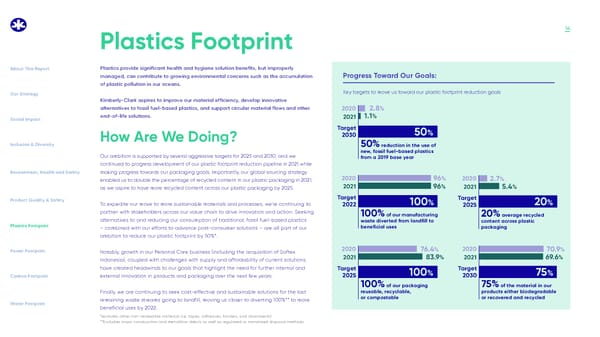75% of the material in our products either biodegradable or recovered and recycled Target 2030 2020 2021 70.9 % 6 9. 6 % 100% of our packaging reusable, recyclable, or compostable Target 2025 2020 2021 76.4 % 83.9 % 14 50% reduction in the use of new, fossil fuel-based plastics from a 2019 base year Target 2030 2020 2021 2.8 % 1.1 % Plastics Footprint Plastics provide significant health and hygiene solution benefits, but improperly managed, can contribute to growing environmental concerns such as the accumulation of plastic pollution in our oceans. Kimberly-Clark aspires to improve our material efficiency, develop innovative alternatives to fossil fuel-based plastics, and support circular material flows and other end-of-life solutions. How Are We Doing? Our ambition is supported by several aggressive targets for 2025 and 2030, and we continued to progress development of our plastic footprint reduction pipeline in 2021 while making progress towards our packaging goals. Importantly, our global sourcing strategy enabled us to double the percentage of recycled content in our plastic packaging in 2021, as we aspire to have more recycled content across our plastic packaging by 2025. To expedite our move to more sustainable materials and processes, we’re continuing to partner with stakeholders across our value chain to drive innovation and action. Seeking alternatives to and reducing our consumption of traditional, fossil fuel-based plastics – combined with our efforts to advance post-consumer solutions – are all part of our ambition to reduce our plastic footprint by 50%*. Notably, growth in our Personal Care business (including the acquisition of Softex Indonesia), coupled with challenges with supply and affordability of current solutions, have created headwinds to our goals that highlight the need for further internal and external innovation in products and packaging over the next few years. Finally, we are continuing to seek cost-effective and sustainable solutions for the last remaining waste streams going to landfill, moving us closer to diverting 100%** to more beneficial uses by 2022. Key targets to move us toward our plastic footprint reduction goals Progress Toward Our Goals: *excludes other non-renewable materials (i.e. tapes, adhesives, binders, and absorbents) **Excludes major construction and demolition debris as well as regulated or mandated disposal methods 50 % 100% of our manufacturing waste diverted from landfill to beneficial uses Target 2022 2020 2021 96 % 96 % 100 % 100 % 75 % 20% average recycled content across plastic packaging Target 2025 2020 2021 2.7 % 5.4 % 20 % About This Report Social Impact Our Strategy Inclusion & Diversity Environment, Health and Safety Product Quality & Safety Plastics Footprint Forest Footprint Carbon Footprint Water Footprint
 Kimberly-Clark Global Sustainability Report Page 13 Page 15
Kimberly-Clark Global Sustainability Report Page 13 Page 15